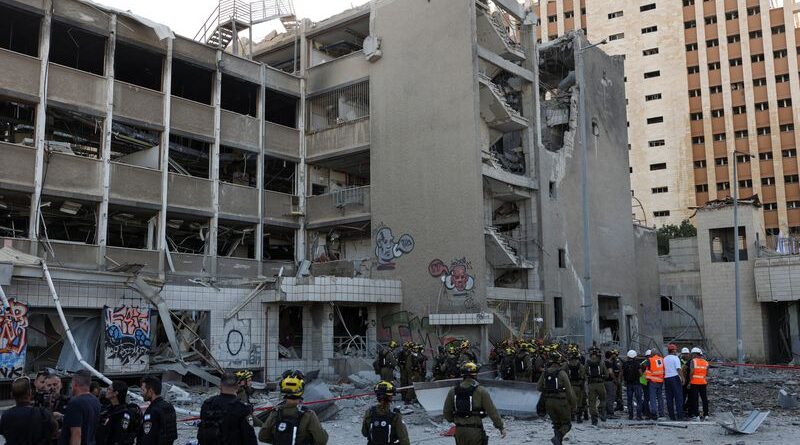ME tensions put investors on alert, weighing worst-case scenarios
Head of Russia’s Rosneft says OPEC+ could speed up oil output hikes by a year
Monitoring Report
NEW YORK: Investors are mulling a host of different market scenarios should the U.S. deepen its involvement in the Middle East conflict, with the potential for ripple effects if energy prices skyrocket.
They have honed in on the evolving situation between Israel and Iran, which have exchanged missile strikes, and are closely monitoring whether the U.S. decides to join Israel in its bombing campaign.
Potential scenarios could send inflation higher, dampening consumer confidence and lessening the chance of near-term interest rate cuts. This would likely cause an initial selloff in equities and possible safe-haven bid for the dollar.
While U.S. crude prices have climbed some 10% over the past week, the S&P 500 has been little changed as of yet, following an initial drop when Israel launched its attacks.
However, if attacks were to take out Iranian oil supply, “that’s when the market is going to sit up and take notice,” said Art Hogan, chief market strategist at B Riley Wealth.
“If you get disruption to supply of oil product on the global marketplace, that is not reflected in today’s WTI price and that is where things get negative,” Hogan said.
The White House said on Thursday President Donald Trump would decide on U.S. involvement in the conflict in the next two weeks.
Analysts at Oxford Economics modelled three scenarios, ranging from a de-escalation in the conflict, a complete shutdown in Iranian production, and a closure of the Strait of Hormuz, “each with increasingly large impacts on global oil prices,” the firm said in a note.
In the most severe case, global oil prices jump to around $130 per barrel, driving U.S. inflation near 6% by the end of this year, Oxford said in the note.
“Although the price shock inevitably dampens consumer spending because of the hit to real incomes, the scale of the rise in inflation and concerns about the potential for second-round inflation effects likely ruin any chance of rate cuts in the U.S. this year,” Oxford said in the note.
OIL IMPACT
The biggest market impact from the escalating conflict has been restricted to oil, with oil prices soaring on worries that the Iran-Israel conflict could disrupt supplies. Brent crude futures have risen as much as 18% since June 10, hitting a near 5-month high of $79.04 on Thursday.
The accompanying rise in investors’ expectations for further near-term volatility in oil prices has outpaced the rise in volatility expectations for other major asset classes, including stocks and bonds.
But other asset classes, including stocks, could still feel the knock-on effects of higher oil prices, especially if there is a larger surge in oil prices if the worst market fears of supply disruptions come true, analysts said.
“Geopolitical tensions have been mostly ignored by equities, but they are being factored into oil,” Citigroup analysts wrote in a note.
“To us, the key for equities from here will come from energy commodity pricing,” they said.
STOCKS UNPERTURBED
U.S. stocks have so far weathered rising Middle East tensions with little sign of panic. A more direct U.S. involvement in the conflict could, however, spook markets, investors said.
Financial markets may be in for an initial selloff if the U.S. military attacks Iran, with economists warning that a dramatic rise in oil prices could damage a global economy already strained by Trump’s tariffs.
Still, any pullback in equities might be fleeting, history suggests. During past prominent instances of Middle East tensions coming to a boil, including the 2003 Iraq invasion and the 2019 attacks on Saudi oil facilities, stocks initially languished but soon recovered to trade higher in the months ahead.
On average, the S&P 500 slipped 0.3% in the three weeks following the start of conflict, but was 2.3% higher on average two months following the conflict, according to data from Wedbush Securities and CapIQ Pro.
Bar chart showing The S&P 500 has tended to languish in the immediate weeks following major past episodes of Middle East conflicts, but has recovered in subsequent months.
Bar chart showing The S&P 500 has tended to languish in the immediate weeks following major past episodes of Middle East conflicts, but has recovered in subsequent months.
DOLLAR WOES
An escalation in the conflict could have mixed implications for the U.S. dollar, which has tumbled this year amid worries over diminished U.S. exceptionalism.
In the event of U.S. direct engagement in the Iran-Israel War, the dollar could initially benefit from a safety bid, analysts said.
“Traders are likely to worry more about the implicit erosion of the terms of trade for Europe, the UK, and Japan, rather than the economic shock to the US, a major oil producer,” Thierry Wizman, Global FX & Rates Strategist at Macquarie Group, said in a note.
But longer-term, the prospect of US-directed ‘nation-building’ would probably weaken the dollar, he said.
“We recall that after the attacks of 9/11, and running through the decade-long US presence in Afghanistan and Iraq, the USD weakened,” Wizman said.
Head of Russia’s Rosneft says OPEC+ could speed up oil output hikes by a year
OPEC+ group of leading global oil producers could bring forward its output hikes by around a year from the initial plan, Igor Sechin, head of Russia’s largest oil producer Rosneft, said on Saturday.
He also said that the decision by the OPEC+ to speed up output increase now looked far-sighted and justified in the light of the confrontation between Israel and Iran.
The Reuters Power Up newsletter provides everything you need to know about the global energy industry. Sign up here.
The Organization of the Petroleum Exporting Countries and its allies, led by Russia, shocked oil markets in April by agreeing a bigger-than-expected output hike for May despite weak prices and slowing demand.
OPEC+ has since decided to continue with more than planned hikes.
“The announced increase in production since May of this year is three times higher than the alliance’s initial plan. In addition, the entire increase in OPEC+ production could be shifted a year ahead of plan,” he said without elaborating.
“The decision taken by OPEC leaders to forcefully increase production looks very far-sighted today and, from the market’s point of view, justified, taking into account the interests of consumers in light of the uncertainty regarding the scale of the Iran-Israel conflict,” he added.
OPEC+ crude output represents about 41% of global oil production. The group’s main objective is to regulate the supply of oil to the global market.
Having spent years curbing production, eight OPEC+ countries made a modest output increase in April before tripling it for May, June and now July.
Besides the 2.2 million bpd cut that the eight members started to unwind in April, OPEC+ has two other layers of cuts that are expected to remain in place until the end of 2026.
Oil prices had initially fallen in response to the OPEC+ decision to increase oil production, but the outbreak of an aerial war between Israel and Iran has so far been the main factor behind their return to around $75 per barrel, levels unseen since the start of the year.
Speaking at the St. Petersburg International Economic Forum, Sechin, a long-standing ally of Russian President Vladimir Putin, also said there will be no oil glut long-term despite the production rise due to low stockpile levels, though rising usage of electric vehicles in China might hit oil demand.
Putin said on Friday he shared OPEC’s assessment that demand for oil will remain high. He also said that oil prices had not risen significantly due to the conflict between Iran and Israel, and that there was no need for OPEC+ to intervene in oil markets.
Sechin also said Rosneft had already budgeted the oil price of $45 per barrel for this year, the level the European Union eyes as the new price cap on Russian oil imports, which is now set at $60.



